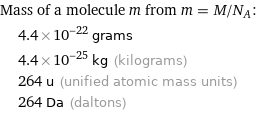Input interpretation
![[4-(1-pyrrolidinylmethyl)phenyl]magnesium bromide | molar mass](../image_source/6b8eaa64f76ae62b2f5ea719f2314ddf.png)
[4-(1-pyrrolidinylmethyl)phenyl]magnesium bromide | molar mass
Result
![Find the molar mass, M, for [4-(1-pyrrolidinylmethyl)phenyl]magnesium bromide: M = sum _iN_im_i Plan: • Write the chemical formula and gather atomic masses from the periodic table. • Determine values for N_i and m_i using these items. • Finally, compute the mass. Write the chemical formula: C_11H_14BrMgN Use the chemical formula to count the number of atoms, N_i, for each element: | N_i N (nitrogen) | 1 C (carbon) | 11 Mg (magnesium) | 1 Br (bromine) | 1 H (hydrogen) | 14 Look up the atomic mass, m_i, in g·mol^(-1) for each element in the periodic table: | N_i | m_i/g·mol^(-1) N (nitrogen) | 1 | 14.007 C (carbon) | 11 | 12.011 Mg (magnesium) | 1 | 24.305 Br (bromine) | 1 | 79.904 H (hydrogen) | 14 | 1.008 Multiply N_i by m_i to compute the mass for each element. Then sum those values to compute the molar mass, M: Answer: | | | N_i | m_i/g·mol^(-1) | mass/g·mol^(-1) N (nitrogen) | 1 | 14.007 | 1 × 14.007 = 14.007 C (carbon) | 11 | 12.011 | 11 × 12.011 = 132.121 Mg (magnesium) | 1 | 24.305 | 1 × 24.305 = 24.305 Br (bromine) | 1 | 79.904 | 1 × 79.904 = 79.904 H (hydrogen) | 14 | 1.008 | 14 × 1.008 = 14.112 M = 14.007 g/mol + 132.121 g/mol + 24.305 g/mol + 79.904 g/mol + 14.112 g/mol = 264.449 g/mol](../image_source/8d983f925fd797fe0e2e859f39a1d3f1.png)
Find the molar mass, M, for [4-(1-pyrrolidinylmethyl)phenyl]magnesium bromide: M = sum _iN_im_i Plan: • Write the chemical formula and gather atomic masses from the periodic table. • Determine values for N_i and m_i using these items. • Finally, compute the mass. Write the chemical formula: C_11H_14BrMgN Use the chemical formula to count the number of atoms, N_i, for each element: | N_i N (nitrogen) | 1 C (carbon) | 11 Mg (magnesium) | 1 Br (bromine) | 1 H (hydrogen) | 14 Look up the atomic mass, m_i, in g·mol^(-1) for each element in the periodic table: | N_i | m_i/g·mol^(-1) N (nitrogen) | 1 | 14.007 C (carbon) | 11 | 12.011 Mg (magnesium) | 1 | 24.305 Br (bromine) | 1 | 79.904 H (hydrogen) | 14 | 1.008 Multiply N_i by m_i to compute the mass for each element. Then sum those values to compute the molar mass, M: Answer: | | | N_i | m_i/g·mol^(-1) | mass/g·mol^(-1) N (nitrogen) | 1 | 14.007 | 1 × 14.007 = 14.007 C (carbon) | 11 | 12.011 | 11 × 12.011 = 132.121 Mg (magnesium) | 1 | 24.305 | 1 × 24.305 = 24.305 Br (bromine) | 1 | 79.904 | 1 × 79.904 = 79.904 H (hydrogen) | 14 | 1.008 | 14 × 1.008 = 14.112 M = 14.007 g/mol + 132.121 g/mol + 24.305 g/mol + 79.904 g/mol + 14.112 g/mol = 264.449 g/mol
Unit conversion

0.2644 kg/mol (kilograms per mole)
Comparisons

≈ 0.37 × molar mass of fullerene ( ≈ 721 g/mol )

≈ 1.4 × molar mass of caffeine ( ≈ 194 g/mol )

≈ 4.5 × molar mass of sodium chloride ( ≈ 58 g/mol )
Corresponding quantities

Mass of a molecule m from m = M/N_A: | 4.4×10^-22 grams | 4.4×10^-25 kg (kilograms) | 264 u (unified atomic mass units) | 264 Da (daltons)

Relative molecular mass M_r from M_r = M_u/M: | 264